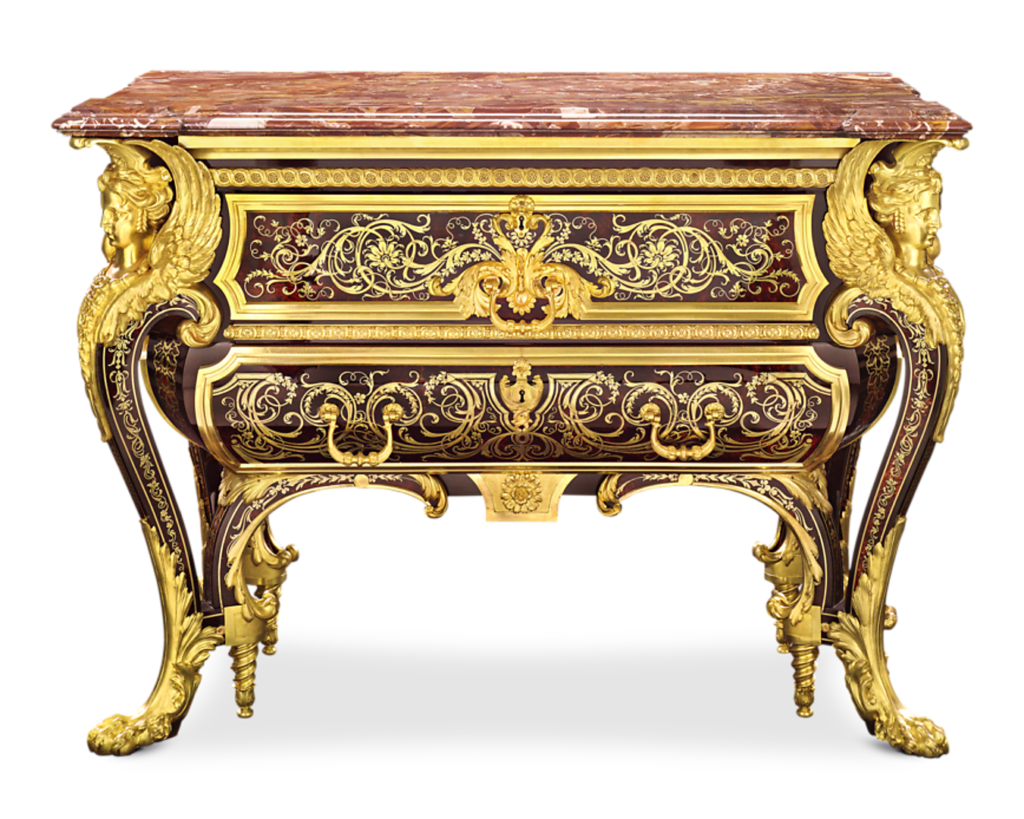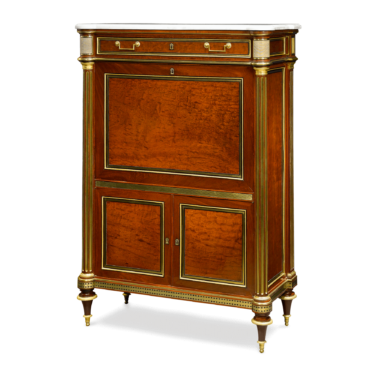Louis furniture refers to an incredible span of creative development over generations of French royalty. Each King Louis had his own distinct style that established a standard of design for the period over which he reigned. However, the infatuation with these styles would continue for centuries, long after the French Revolution put an end to the seemingly limitless grandeur and luxury that so defined the French aristocracy. Below, find some telltale ways to identify these antique furniture gems of 18th century French style.
Louis XIV | 1643-1715

This 18th century French furniture piece, a commode, is based on an original by Boulle that graced the halls of Versailles during Louis XIV's reign. Embodying the ethos of Baroque design, this commode has an unsurpassed level of detail and awe-inspiring opulence which was intended to dominate and impress. Shop the commode
Louis the XIV, often called the Sun King, brought a golden age of art, music, and leisure to the lavishly adorned court he presided over at Versailles. The substantive and extravagant style that flourished during his reign was known as Baroque. Full of gilded flourishes and bold forms, the King used the grandeur of Baroque design as a symbol of his majesty and reign.
Louis XIV brought the most talented artists and craftsman from all over
Europe to Paris to establish the city as the greatest name in production of luxury goods. One of his most accomplished artisans was the famed cabinetmaker Andre Charles Boulle, who was without a doubt the master of using inlay materials such as brass, pewter, horn, tortoiseshell, and mother of pearl into ebony to create stunning 18th century french furniture pieces.
The 18th century also brought with it a taste for functional and decorative objects such as chandeliers, mirrors, and statuettes in furniture design. This opulent depiction of Louis XIV as a Roman hero is a perfect example of the luxurious design and materials of the period. The gilt bronze sculpture is a reduction of a version that was originally erected in the Place Louis-le-Grand (now called the Place Vêndome), but the statue was destroyed during the Revolution in 1792 to be melted down for making cannons. Shop Louis XIV style »
Louis XV | 1715-1774

With its curved shape, intricate rosewood marquetry and gilded ormolu decoration, this lovely antique desk is an excellent example of the Louis XV style in furniture design. This 18th-century furniture piece was created by the renowned Theodore Millet, founder of the widely acclaimed Maison Millet in Paris. Shop the desk
The reign of King Louis XV saw a change in venue for the royal court, back to a more intimate setting in Paris. Leaving behind the grandeur of Versailles in favor of more intimate spaces, Louis XV and his court prized a lighter, smaller aesthetic that functioned well in smaller city residences. The resulting Rococo style was lighter and more practical than Baroque design, and was characterized by romantic, swirling flourishes with elegant curves. Ornamentation in Rococo style often featured flora, fauna, and shells. The detailing on these pieces was sensuous yet delicate, but still typically utilized the finest materials including ormolu gilding and exotic imported woods. However, slightly less ornate (and therefore less expensive) versions of these designs became increasingly popular in lower classes as well, spreading the style throughout French society. Shop Louis XV style »

Louis XVI | 1774-1791

This vitrine in the Louis XVI style has the clean, elegant lines and right angles of the period, as well as exceptional marquetry in kingwood, simple ormolu ornamentation and a neoclassical-style depiction of a woman and an angel on the center mount at the bottom. Shop the vitrine
During the reign of Louis XVI, a growing air of simplicity overtook french society and interior decoration. Rich, ornate decoration was forgone in favor of cleaner lines. A more orderly style with minimal ornamentation was preferable, in part due to the rise of Enlightenment thought in society that encouraged rationality, purity, and morality. The restrained Neoclassical style was encouraged by an infatuation with ancient culture after the discoveries of ruins at Herculaneum and Pompeii. Quietly elegant Louis XVI pieces often featured straight lines and right angles, with symmetrical structure and architecturally styled details. Shop Louis XVI style »

Neoclassical influence is evident in this lovely giltwood console table. With it's delicate floral motif, column style legs, and lightweight structure it embodies the principles of symmetry and simplicity so prized in the Louis XVI era. Shop the console
Directoire

This secrétaire à abattant was crafted by Bernard Molitor, one of few artisans who's furniture making business was successful both during the Monarchies and after the Revolution. This secrétaire, circa 1790, is made of mahogany and accented delicately with ormolu mounts and a white marble top. Shop the secrétaire
After the French Revolution, any excess ornamentation was shunned in favor of a highly functional and restrained, yet aesthetically pleasing, design. The French public resented the opulence and luxury that had characterized the Monarchy. As the general public began to amass some personal wealth, they wanted sophisticated pieces to furnish their homes, yet were not so fixated on materials and craftsmanship. These pieces were often made more quickly to supply growing demand, and typically featured antique decoration motifs with imagery from Greek, Pompeiian, and Egyptian societies, but overall came to represent equality of all citizens in the new Republic. Shop Directoire style »

This Directoire-style dining suite illustrates the minimally adorned style that became favorable after the French Revolution. While elegant and comfortable, there is minimal gilding and very little ornamentation or decoration on the chairs and dining table within these pieces of furniture. Shop the Dining Suite
Inerested in adding a French antique furniture piece to your home? Shop our large collection of elegant dressing tables, chests, armoires, tables and more right on our website or at our showroom.







